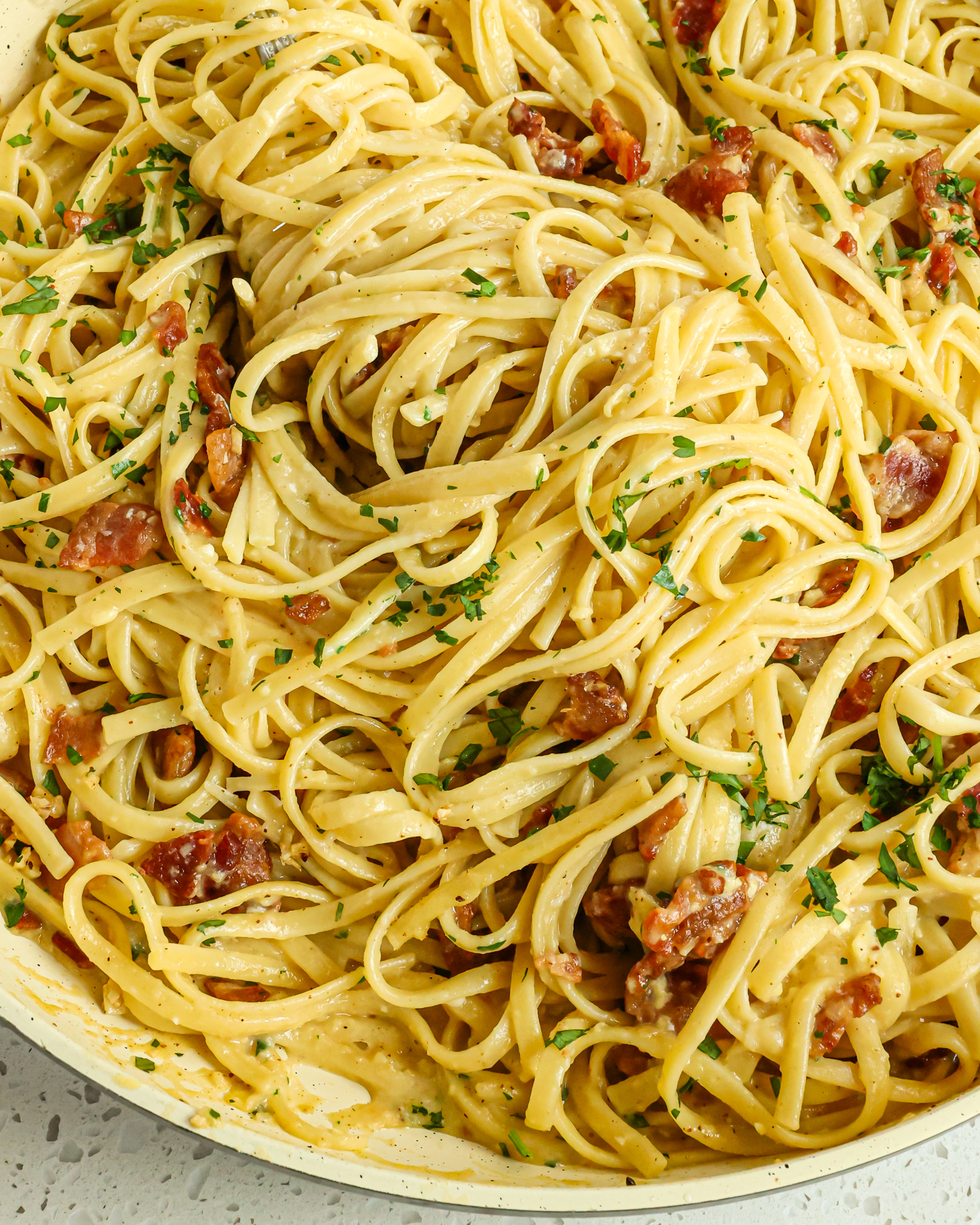Instructions
- Put a large pot of salted water on the stove over medium-high heat. Bring to a boil.
- In a large bowl, whisk together the eggs, egg yolks, and Parmesan cheese. Set it aside for a few minutes.
- Cook bacon over medium heat in a large skillet until crispy. Using a slotted spoon, remove to paper towels to drain. Remove all but 1 1/2 tablespoons of bacon grease from the skillet and discard.
- Reduce the heat to low and add the minced garlic to the skillet. Cook and stir continuously for 1 minute.
- Meanwhile, cook the pasta al dente according to package directions. Reserve 1-2 cups pasta water. Drain the pasta.
- Now working fairly quickly, add the hot cooked pasta to the skillet with the bacon fat and garlic, tossing quickly to coat. Beat the egg mixture again for a few seconds. Turn off the heat and slowly pour in the egg/parmesan mixture and a splash or two of the pasta water with one hand while tossing frequently with the other hand. Once the egg mixture is fully incorporated, add more pasta water till the desired consistency is reached. Add the bacon back to the skillet and toss again.
- Season with kosher salt and freshly ground black pepper to taste. Top with fresh Italian parsley and, if desired, more grated Parmesan Cheese.
Notes
- Bring your eggs to room temperature and use large eggs.
- The key to great pasta carbonara is timing. The pasta should be hot when you add the egg mixture and toss it. Try to keep the pasta water hot as well. Have everything you need right by the stove, including tongs, pasta water, chopped parsley, egg mixture, and cooked bacon.
- Thick-cut bacon, pancetta, pork jowl, or guanciale are all suitable choices for this pasta.
- Spaghetti, fettucine, linguine, bucatini, and rigatoni are all pastas used in carbonara.
- Don’t forget to reserve 1-2 cups of pasta water. It is great for getting the pasta sauce to your desired consistency. Slide a large bowl under the colander before you drain the pasta, and you can’t forget.
- Turn the heat off before adding the egg mixture to the skillet to keep from scrambling the eggs.
- Store any unused pasta water in a mason jar with a tight-fitting lid for 2-3 days. Use it to reheat leftovers.
- Use fresh grated Parmesan cheese (Parmigiano Reggiano), not the stuff in the canister, as it melts so much better and tastes far superior. Pecorino Romano is just as delicious if available.
- For the ultimate flavor, top the finished dish with finely chopped parsley and a little more freshly grated Parmesan cheese.
- This dish is best served as soon as it is prepared, so try to plan accordingly.
- Store leftovers in an airtight container in the fridge for up to 3 days. Reheat on the stovetop over very low heat, adding a couple of tablespoons of reserved pasta water and tossing to warm.
Nutrition
Calories: 640kcal | Carbohydrates: 60g | Protein: 25g | Fat: 32g | Saturated Fat: 12g | Polyunsaturated Fat: 5g | Monounsaturated Fat: 13g | Trans Fat: 0.1g | Cholesterol: 204mg | Sodium: 698mg | Potassium: 361mg | Fiber: 3g | Sugar: 2g | Vitamin A: 585IU | Vitamin C: 4mg | Calcium: 192mg | Iron: 2mg

